Some people play gigantic space game Elite: Dangerous to lead humble, (relatively) ordinary space lives. They do missions, make deliveries and decorate their cockpits with silly little bobbleheads. Then there’s The Great Expedition.
The First Great Expedition began with a single goal: to collectively explore all of Elite: Dangerous‘ 400 billion star systems — or at least, as many of them as humanly possible. The recently launched space sim contains a massive galaxy modelled after our own Milky Way, its twinkling nebulae knit together by human hands and procedural algorithms rooted in real science.
To explore as much of it as they could, some members of this expedition would forsake the rest of the game and just dive into the black unknown. This isn’t like in other games, either; travelling back to civilized space isn’t as simple as a quick press of a button, nor is plotting routes or figuring out what you’re gonna encounter. We’re talking thousands upon thousands upon thousands of light years of space. This isn’t just a project you knock out on a lazy Sunday afternoon.
A little less than a year ago, a gamer named Steve “Gibbonici” Wilds put up a post looking for fellow explorers. At that time, Elite: Dangerous wasn’t officially released. In fact, it wasn’t even close to presenting a complete, openly traversable galaxy. But there would be space to explore, more than one man could see/catalogue. Wilds expected responses from maybe 15 or 20 people. Instead, he found himself with over 1,000. His team would go on to attract amateur astronomers, astrophysics experts, and one ex-NASA scientist.
Members of the Expedition spend their time in the game exploring uninhabited areas in deep space, charting the stars, planets, and pitfalls they find, and relaying information back to other members of the group. Some put in more time than others, some occupy specialised roles, but still, it all goes back to a singular purpose: to see and understand as much of space as possible.
“There are some extremely knowledgeable amateur astronomers with us who are keen to visit some of the stellar bodies they have been looking at through their telescopes,”Wilds told me via email, explaining why some people signed up for his Great Expedition into the virtual galaxy. “We’ve got people who love the idea of playing with others but not in doing the same old guild/corp thing. And there are more than a few who had no interest in exploring at all until they stumbled across us.”
Exploring, however, is not as simple as pointing your spaceship in one direction, cranking some classic rock, and shouting “yeeeehaw.” Planning and logistics are key in a simulation where you have to account for things such as limited resources,overheating spacecraft engines, complex travel routes, and the occasional black hole. The Great Expedition, while not quite as demanding as, say, a major corporation in long-running space game EVE Online, has to be a well-oiled machine.
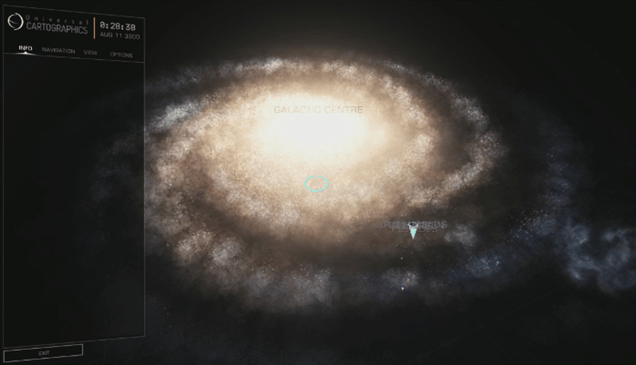
That’s important. Virtual outer space is a dangerous place, especially when it’s rooted in actual scientific fact, courtesy of Elite‘s Stellar Forge galaxy generation system. That tech cooks up the game’s galaxy by accounting for the chemical composition, gravity, orbits, mass, and actual scientific phenomena we’ve witnessed in the real Milky Way.
The Great Expedition’s ex-NASA scientist, Gryffin du Verd, explained:
“I find myself falling into ‘mission planning mode’ when I get ready to leave the stations. The frameshift drive/supercruise model in the game doesn’t behave like normal orbital mechanics as you would think of with the shuttle (burn the engine on this side of planet to effect an orbit change on the other side), but the planets do have effects on your ship, slowing you down and sometimes ‘slingshotting’ you around the other side as Kepler’s 2nd Law says it must. So, while the tasks are different, the mindset is surprisingly similar [to what I did at NASA].”
The Expedition team plotted and planned their charting of the game’s galaxy long before Elite: Dangerous‘ official launch. That enabled them to pre-establish a set of roles for players. Today, there’s a core staff of around 10 people responsible for laying down the figurative tracks, or figuring out where people should go. There’s also a “wing” system in place to handle issues like scouting and defence as they come up during exploration.
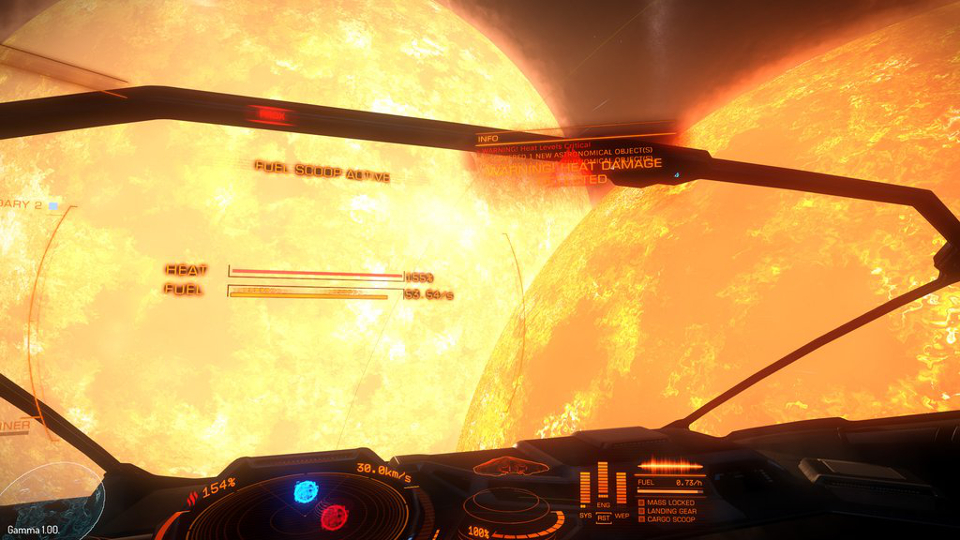
In between all the Milky Way derring-do, people are also needed for more mundane tasks like managing base camps — which serve as central meeting points for about a week at a time — and charting progress. Then there’s perhaps the most important role of all: the pathfinder.
“The main specialist role we run at the moment is the Pathfinders group,” explained Wilds. “They’re the guys who scout ahead and build up the routes for everyone else to follow. The ‘official’ Pathfinders group is about eight strong at the moment, but the great thing about explorers is that they tend to be very self-motivating, so we don’t have to send anyone out anywhere — they’re just doing it under their own initiative.”
“A few [pathfinders] have been out to the Orion Nebula (spectacular place to visit, nestled at the foot of the Horsehead Nebula with Barnard’s Loop overhead — and the Orion stellar nursery is breathtaking), others have been to the ‘roof’ of the galaxy, and one of our guys, Zulu Romeo, even made it all the way to Sagittarius A*, the black hole at the center of the galaxy. All of these trips people are doing give us a great insight into the travel times and obstacles we’ll be facing during the Great Expedition.”
But why? Why put all this time and manpower into exploring and not, say, amassing space dumptrucks of glittering space loot? Everyone has their own reasons for wanting to venture into space’s cold nothing until there’s nothing left to venture into, but du Verd made his case with the most passion:
“I’m troubled by the fact that many of us have lost our interest and maybe even our ability to explore the world around us — not just space, but everywhere,” he said. “My fear is that the ‘average’ player will get in the game and say, ‘Oh, another star, another planet. No combat or trade stations? Let’s move on.’ Frontier has put 400 billion star systems in the game, but unless people are curious about what’s out there, very few of those stars will be of interest to anyone. They could just as well have set it in an entirely fictional galaxy, and no one would have noticed. And that, really, is the problem: We aren’t curious anymore.”
At the moment, the main thrust of The Great Expedition — the part where players drop everything for the sole purpose of exploration — hasn’t begun. Wilds and co decided to hold off for a bit to wait for Elite: Dangerous to gain some additional features like extra player character slots so people wouldn’t have to use their game accounts solely for exploration. That, however, hasn’t stopped them from running other big expeditions. The results have been eye-opening, to say the least. There was always a big question looming over The Great Expedition: “Can we actually do this? Is this really feasible at this scale?” The wait, the smaller expeditions, have turned out to be blessings in disguise.
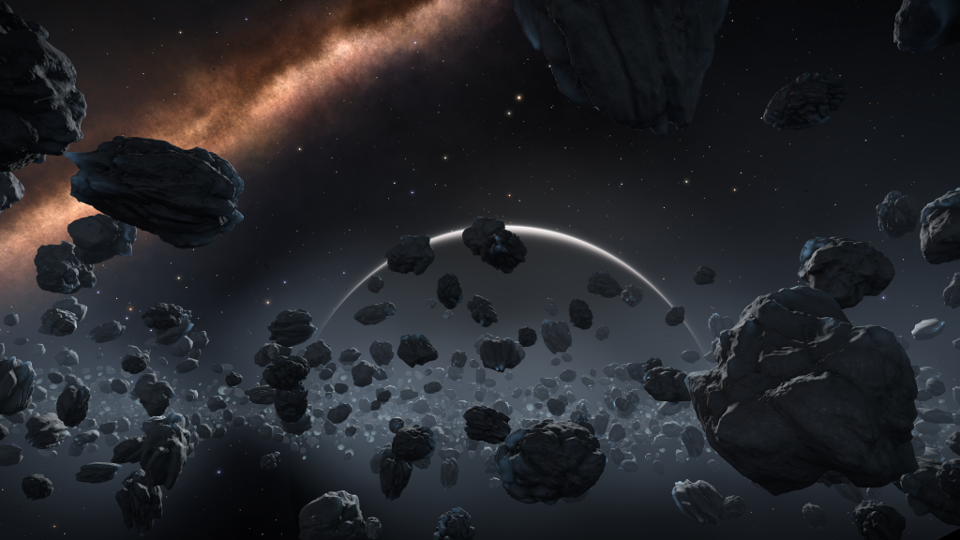
“It was a hard decision to take at the time, but it was definitely the right one,” said Wilds. “It gives everyone more time to build excellent exploration ships, and it will give us chance to really nail down all the details of moving, exploring and working as a team. It’s amazing how many ideas that sound great on paper actually turn out to be useless when you try them out for real.”
That also hasn’t stopped them from uncovering some wild surprises nestled amongst the stars.
“Every few days system maps are being posted on [The Great Expedition] forum showing some really crazy systems,” said Wilds. “Some of them have nothing but stars in them, all locked in weird orbits with each other. Others have multiple black holes with all kinds of weird and potentially destructive stuff going on.”
“For some of us the real surprises come when you’re on your way to a nebula or dark region or whatever. You scoop your fuel, then head away from the mainstar to plot your next series of jumps in the galaxy map. Sometimes, when you close the galaxy map with your course plotted, you’ll be treated breathtaking view of your target nebula with stars scattered across it like jewels cast over silk, and you just have to take it all in. Screenshots can’t do those views any justice at all. They just lose all sense of scale. God knows what they must be like in the [Oculus] Rift.”
The ex-NASA worker du Verd has found himself pleasantly surprised by how well the game’s Stellar Forge adheres to scientific principles, all the way down to little details most players won’t even care about.
“What I find to carry over more than NASA work is my research in astrophysics,” du Verd said. “For example, when I run across a T Tauri star, I expect to find strong stellar winds and a lot of activity on the surface of the star. Another example came up in planning the Expedition itself: Are there stars between the spiral arms that we can use to cross down to the galactic core? The science says there should be lots of dim red stars (since they live a long time) and very few blue stars (since they die comparatively quickly). I was pleased when our early scouts came back and reported that was exactly what they found as they explored coreward. I find that having that background in astrophysics makes it more ‘real’ than just a game, and that’s no small feat.”
It’s hard not to be impressed by what Wilds, du Verd, and the rest of The Great Expedition have achieved so far, but there are still questions. Four hundred billion star systems is, you know, a lot. How long can The Great Expedition last? What if people get bored?
“Yeah, that’s the question, isn’t it?” admitted Wilds. “For all the passion and enthusiasm we’ve got for this thing, exploration is going to lose some of its appeal six months down the line. There’s no getting around that, and it’s something we’ve been conscious of right from the start. You can’t start something like this without being realistic about its longevity or being aware that patience is part of the challenge.”
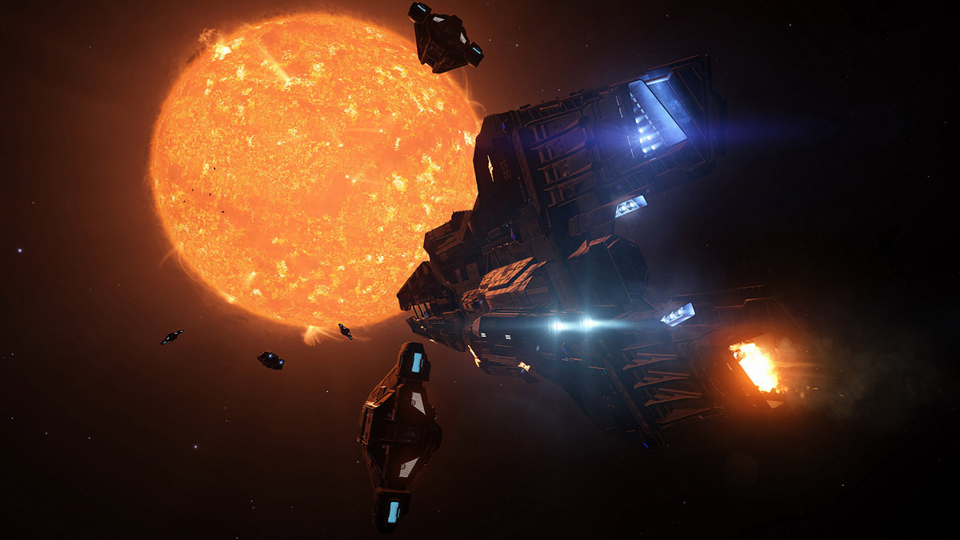
The hope, then, is that once Elite developer Frontier adds extra player character slots, people will be OK with dedicating one character to The Great Expedition’s cause. For now the wait is bittersweet, but according to Wilds it’s better than the alternative. “It would be a wasted opportunity if we set off now only for everyone to fly back to civilisation after a month,” he said.
You can’t stop explorers from exploring, though. At best, you can only slow them down. Whether blazing a trail through the star-speckled skies as one giant force or a series of smaller groups, The Great Expedition will continue. I wonder what they will find.
Videos/pictures: Erimus One, Titus Balls, The First Great Expedition
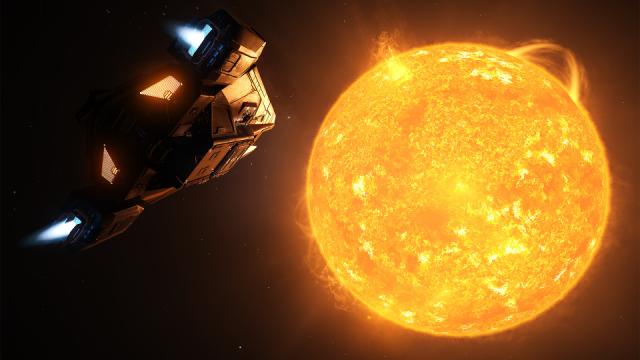
Comments
17 responses to “Game Recreates Entire Galaxy, 1000 Players Determined To Explore It”
Does anyone have this game ? used to play a lot of freelancer when i was younger wondering how it compares before i make the purchase.
@mrtaco Your presence is requested.
I haven’t played Freelancer so am of no use 😛
Well let me weigh in on the Freelancer angle @busa91, then perhaps @mrtaco can tell you what Elite does better.
From everything I’ve read, yes, this is Freelancer for a new age. Dogfights, resource management, you control a single seater spacecraft.
I don’t know whether there are commodities you need to trade. It’s an MMORPG so it’s constantly in multiplayer mode.
Not sure about story, but Freelancer’s was never brilliant. Ok, but not brilliant.
Uhhh…you fly in first person mode in this one and it has Rift support.
…that’s about it. Essentially, from what I’ve read, if you liked Freelancer, get this. Now.
Also what about this vs Star Citizen ?
As a complete game, Star Citizen doesn’t really exist yet. It’s just two arenas to fight people in.
I have Elite Dangerous, and I quite like it. Played many many hours since its release. I never played the old space sims so I can’t compare it to them though.
If the developers are to be believed, this game has everything from the first Elite and more, and things are going to be updated in the coming 2 years. Like landing on planets and walking or driving around in first person (as you could do in Elite 2) and also Coop commanders, flying your huge ship through space manned by more than 1 player. Also this thing is already Oculus Rift optimized for when it gets released so I bought it early for that reason.
Star Citizen is currently extremely short on content – there’s no open world to explore, no trading, mining, etc, etc. If Star Citizen is eventually finished, it might be better to make comparisons then – right now, the only reason to buy Star Citizen is if you like tech demos and waiting.
I also wouldn’t compare ED much to Freelancer (having played both). Freelancer felt much more rich in story. ED does not have any kind of central story or plotline whatsoever. You can take missions for the various factions but they’re essentially disconnected one-off missions and they all start to feel pretty same-y quite quickly.
As for ED on it’s own merits… well, there’s an enormous, beautifully rendered galaxy to explore. The combat is pretty enjoyable… but… Well, it’s the kind of game where you have to make your own fun to a pretty large extent. If you just want to earn money quickly you can trade, but that’s not terribly exciting (think Truck Simulator in space but with far less actual involvement). Mining seems to be really boring and take too long to be viable as a way of really making money. Combat is fun, but it can often feel pointless because the rewards are fairly small. Exploration can be cool, but again… it can end up feeling pretty pointless since your actual interaction with the cool stuff you find is pretty much nil.
I make the game sound terrible, but I’ve actually been playing it quite a lot. The main “hook” I think is supposed to be these galactic events which happen (partly player-created, partly scripted in by the devs) and you can, say, fly over to a system having a slave revolt and either help the slaves or the law. You’re still doing the same few fairly repetitive activities but the greater context and the fact that other players are also influencing events makes it feel a bit less pointless. You’ll also occasionally have funny things happen that’ll make a cool micro-story, like you see in games like DayZ.
At the end of the day, I like it a lot, but it’s a hard game to recommend. There are long periods of playing it that can be very boring and you need to work pretty hard to actually find the fun content in it. A certain crowd of people who like more sedate experiences will get a lot of enjoyment out of it, but I expect the majority of people will find the game to feel pretty empty and pointless.
The good news is the devs have said they plan to add major new features for a while into the future. So maybe in a year or two the game’ll be something to be more excited about for a greater number of people.
Here’s how it is. Some parts are great, some parts are lacking in any substance. Strange choices like having awesome graphics, awesome sound, some fairly generic sci fi music but apparently people don’t have voice boxes in the future as the only voices you will ever hear is your computers and the automated announcements inside stations (same voice). Missions are highly forgettable for the most part but are pretty much the only way to earn faction rep, with 3-4 unique factions in habitated systems that have complex relationships where you gain/lose rep with every faction in their web when you gain/lose faction with someone. Combat can be great but you’ll need to learn to use Newtonian movement to get the most out of it.
Goddamnit! I don’t want to have to choose between this and Star Citizen. I’m gonna need another 9 hours in the day! 🙁
With all the space games coming in the near future would this be a good time to buy some kind of joystick/flightstick/fancy flight sim setup? It’s been years since I considered this..
If so, can anyone recommend a few for PC? Like, best for the money sort of stuff…
Or will the good ol’ xbox controller do the trick?
I use mouse/keyboard and it works fine, I plugged in xbone controller and it worked fine but I prefer m/k for some reason, the dedicated ppl on the forums get a Saitek Pro Flight X-55 stick/throttle combo + use the voice attack software for some controls so they never have to take their sweaty palms off of them.
Man, exploring was the thing making me consider this game. Not sure if this great expedition would make it more fun if I jumped in now or a waste of my limited play-time.
What id like to know is if theres alien races outside the factions that you could discover. If its just 4 factions in the “civilized” regions then just a metric crapload of unpopulated systems (as beautiful and acurate as they may be ) then no deal sorry.
There currently aren’t any alien races. Although according to the game’s executive producer Thargoids (aliens from older games in the franchise) are coming at some point.
But yeah, that’s pretty much the gist of the game right now. There’s an area of space that’s highly populated (quite a large area speaking absolutely – several hundred star systems at least, possibly thousands, I’m not sure) and then a whole lot of space with not much in it other than “Oooh, that’s a cool system configuration” every now and then.
Then again, the galaxy is so ridiculously huge I suppose it’s entirely possible there are aliens out there and we just haven’t found them yet.
Loving this game so far. The updates for it are a bit wonky sometimes (takes hours and can have validation errors) but it is o so worth the wait. I used to play the 1st Elite game back in the days of games that went boop boop beep beep in 16 colors. This however, is something different entirely. Instantly hooked on jumping through time and space to new unexplored systems, meeting different players (we need more btw, your influence on the galaxy is greatly appreciated!) I think if you are into space simulators then this is definitely your game. If you are a sucker for big maps.. well then this is YOUR game. It’s a 1:1 scale of the entire galaxy haha.
Become a bounty hunter or a tradesman/woman. Explore systems and sell star charts.
My goal is to own one of those bigass type9 Lakon ships one day 🙂
If I could buy this game this is what I’d do.